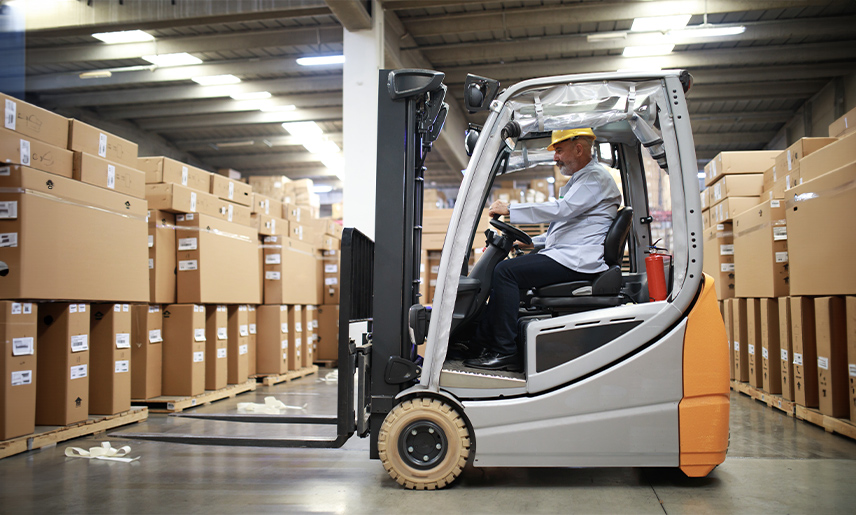
There are no moving parts on an electric motor. Once that game-changer sinks in, it’s plain to see why electric forklifts now comprise 64% of the North American lift truck market, according to the Industrial Truck Association (ITA). In addition to the lack of moving parts and corresponding savings on maintenance, electric forklifts supply other benefits to industrial warehouses, docks and construction sites:
- Lower operating costs during the lifetime of the equipment due to lower maintenance and more affordable “fuel” in the form of electricity rather than gas/diesel
- Zero direct emissions for better indoor air quality
- Quiet operations compared to internal combustion engine (ICE) operation
- Longer anticipated lifespan of service
- Access to incentives and credits (local or federal) for choosing an eco-friendly EV
As companies transition to electrifying forklift fleets, facilities need to set up the proper commercial EV charging infrastructure. There are two options, depending on the usage patterns and goals for the materials handling fleet or equipment.
Commercial EV charger selection for powering electric forklifts
There are two main chargers suitable for electric forklifts: a Level 2 AC charger or a DC fast charger. The right choice depends on the number of forklifts in operation per shift, operating hours, battery capacities and budgets.
Level 2 EV chargers
Level 2 or AC chargers work well for forklifts operating on a standard eight-hour shift, offering facilities a certified, reliable charging solution backed by the California Type Evaluation Program (CTEP). The forklift can fully recharge the batteries overnight when not in use. Typical Level 2 chargers provide between 6-10 kW of power, replenishing 20-25 miles of range per hour of charging.
Level 2 chargers can be installed at dual charging stations or wall-mounted, depending on the facility’s layout and needs. The initial installation carries lower equipment costs compared to DC fast charging.
Depending on the type of fuel cell, the size of the battery, and the demands on the equipment, companies might find Level 2 to be the best option. There are lower equipment and installation costs compared to a DC fast charging station. However, in a fast-paced, demanding environment where multiple forklifts need to operate on more than a single eight-hour shift, the slower charging times could pose a detriment to maintaining charging levels for production demands.
DC fast EV chargers
DC fast chargers rapidly fuel up fleets such as EV forklifts to return the equipment to service in the warehouse, factory, or dock. By providing DC power directly to the battery pack, these chargers can restore up to 80% of battery capacity in just 1-2 hours, depending on the charge rate.
The higher the kW rating, the quicker the charge time. DC fast chargers from BTC POWER are available in 120, 150 or 180kW. These units require facility preparation to set up the electrical infrastructure necessary to power the chargers, such as installing a transformer and making the appropriate connections.
DC fast charging stations pose the best option for fleets that run extended shifts around the clock and must keep trucks in rotation. The ultra-rapid recharging minimizes battery swapping and reduces time wasted waiting on a full charge. As battery technologies advance, some sources say that users can realize two full shifts of forklift usage from a single charge.
The GEN 4 180 kW AiO EV Charger and the Split System 360kw EV Charger are both NEVI qualified.

Key charging considerations for electric forklifts
Whether deciding to install Level 2 or DC EV fast chargers, there are some other factors to keep in mind when outfitting an electric forklift fleet:
- Charging window – How much cumulative charging time is available based on the operating schedule? This will determine if Level 2 or DC fast charging makes more sense.
- Battery capacity – Forklifts have larger battery packs than cars/trucks, ranging from 20kWh up to 80kWh. This impacts charge times and electrical loads.
- Space and ventilation – Charging areas should be well-ventilated since even lithium-ion batteries can emit harmful gases. Spacing chargers every 20 feet or so is recommended.
- Power management – For larger fleets charging concurrently, load management systems can modulate charge levels to prevent maximum electrical draw spikes that could overload circuits.
- Facility integration – For DC fast charging, coordinating installation with utility providers is critical to ensuring adequate electrical service and transformer capacity.
Whether using Level 2 or DC EV fast charge stations, operators will also need to follow best practices like:
- Not unplugging before the charge cycle finishes to avoid battery drain
- Keeping chargers clear of any obstructions or flammable materials
- Turning forklifts off during charging
- Using only chargers compatible with the specific battery/forklift model
Companies can maximize the efficiency, cost-savings and sustainability benefits of deploying an electric forklift fleet by taking the right approach to commercial EV charging infrastructure. Best practices and best results are derived from understanding the unique charging needs of these workhorses is crucial.
Safety benefits with electric forklifts
| Reduced emissions and improved air quality | Improved visibility and maneuverability |
| Consistent power delivery | Reduced risk of fires and explosions |
| Lower noise levels | Lower center of gravity |
| Enhanced stability and control | Ergonomic benefits |
| Environmental safety | Compliance with safety regulations |
Benefits of electric forklifts
Electric forklifts are growing in popularity, with many companies finding electric forklifts are the best option for their warehouse, port or other material handling locations. The benefits of electric forklifts include safety, power efficiency and reduced emissions.
No direct emissions
One of the biggest advantages of electric forklifts is the complete lack of direct emissions from an ICE. This is particularly important for indoor operations in warehouses, distribution centers, manufacturing facilities, etc.
Traditional gas, diesel or propane forklifts produce emissions like carbon monoxide, nitrous oxides, particulate matter, and hydrocarbons. Exposure to these emissions in enclosed environments can cause health issues for workers and negatively impact indoor air quality.
Due to their toxicity, OSHA regulates maximum permissible exposure limits for carbon monoxide and nitrous oxide. Exceeding these limits requires additional ventilation or operators wearing respirators – adding costs and creating a worse working environment.
By generating zero direct emissions, electric forklifts allow facilities to provide better air quality for workers, avoid costly ventilation requirements, and create a greener worksite overall. Emissions reduction is valuable for outdoor job sites and minimizing local pollution.

Quieter, safer operations
Switching to electric forklifts also leads to a drastic reduction in noise levels compared to ICE models. The primary sources of noise from an ICE forklift are:
- Engine combustion cycles
- Exhaust and cooling fan noise
- Mechanical drivetrain noise
Levels can reach 80-90 decibels (dbA) during operation, which is equivalent to a gas-powered lawnmower about 3 feet away. Sustained noise above 85 dbA can cause permanent hearing damage over time.
In contrast, electric forklift noise comes only from smaller traction motors and lifting hydraulics – generally producing just 60-70 dbA. This substantial 20-30 dbA reduction makes an enormous difference in making work environments safer and less fatiguing, especially in enclosed spaces that can amplify engine noise.
Less noise also improves workplace communication, increasing safety and productivity. It reduces the need for backup alarms or headphones to isolate workers from their surroundings. The quieter operation benefits any application – warehouses, manufacturing plants, shipping terminals, construction sites, etc.
While regulations vary, OSHA mandates that any noise over 90 dbA requires hearing protection, and levels over 85 dbA require annual audiograms for workers. Electric forklifts provide a way to help facilities comply with these regulations while improving the work environment.
Transform your warehouse or manufacturing operations with the eco-friendly, cost-effective, and productivity-enhancing benefits of electric forklifts powered by domestically manufactured and readily available L2 and DC fast chargers from BTC POWER. With zero emissions, quieter operation, lower maintenance costs, and reliable charging solutions, it is time to electrify your materials handling and join the sustainable future of logistics. Contact BTC POWER today to learn more about our commercial EV charger options for charging fleets of all types.
BTC POWER is the largest EV charger manufacturer in the country providing the top commercial EV charging stations for fleet and commercial vehicles.

